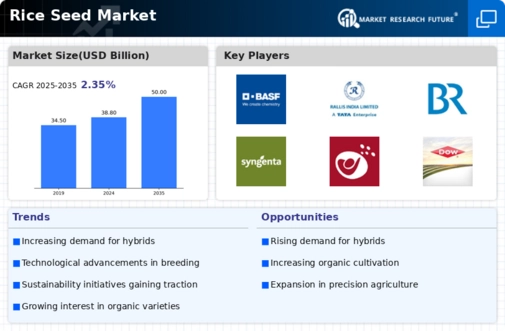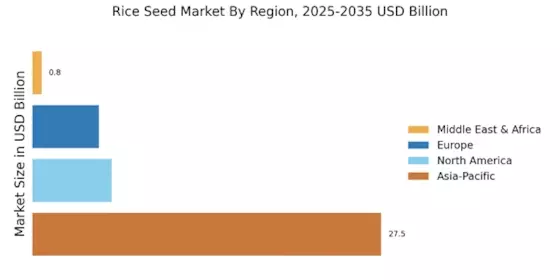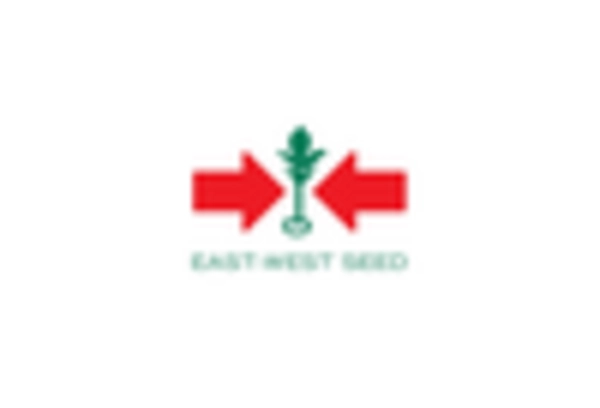Climate Change and Adaptation Strategies
The impact of climate change is becoming increasingly evident in the Rice Seed Market. As weather patterns shift, rice farmers are facing challenges such as droughts, floods, and rising temperatures. In response, there is a growing emphasis on developing climate-resilient rice varieties that can thrive under adverse conditions. Research institutions and seed companies are collaborating to create seeds that are not only high-yielding but also adaptable to changing climates. This focus on resilience is crucial, as it is estimated that climate change could reduce rice yields by up to 20% in some regions by 2050. Therefore, the adaptation strategies being implemented within the Rice Seed Market are essential for ensuring food security and maintaining production levels in the face of environmental challenges.
Government Initiatives and Support Programs
Government initiatives play a pivotal role in shaping the Rice Seed Market. Many countries are implementing policies aimed at boosting agricultural productivity and ensuring food security. For instance, subsidies for seed production and research grants for developing new rice varieties are becoming more common. These initiatives are designed to encourage farmers to adopt improved seed technologies, which can lead to higher yields and better quality produce. Additionally, governments are increasingly recognizing the importance of sustainable practices, promoting organic rice farming and environmentally friendly seed production methods. Such support not only enhances the competitiveness of the Rice Seed Market but also aligns with global sustainability goals, potentially attracting more stakeholders to invest in this sector.
Rising Demand for Rice in Developing Economies
The Rice Seed Market is significantly influenced by the rising demand for rice in developing economies. As populations grow and urbanization accelerates, the need for staple food sources like rice is becoming more pronounced. Countries in Asia and Africa are witnessing a surge in rice consumption, with projections indicating that rice demand could increase by 30% by 2030. This growing demand necessitates the development of high-quality rice seeds that can withstand varying climatic conditions and pests. Consequently, seed producers are focusing on enhancing their product offerings to meet these needs. The increased consumption patterns in these regions are likely to stimulate investments in the Rice Seed Market, fostering innovation and expansion.
Technological Innovations in Rice Seed Production
The Rice Seed Market is experiencing a surge in technological innovations that enhance seed quality and yield. Advanced breeding techniques, such as CRISPR and marker-assisted selection, are being adopted to develop high-yielding and disease-resistant rice varieties. These innovations are crucial as they address the increasing demand for rice, projected to reach 520 million tons by 2025. Furthermore, precision agriculture technologies, including drones and satellite imagery, are being utilized to optimize planting and harvesting processes. This not only improves efficiency but also reduces resource wastage, thereby contributing to sustainable practices within the Rice Seed Market. As farmers increasingly adopt these technologies, the overall productivity of rice cultivation is likely to improve, further driving the market forward.
Increasing Investment in Agricultural Research and Development
Investment in agricultural research and development is a key driver of the Rice Seed Market. As the need for innovative solutions to enhance rice production grows, both public and private sectors are channeling funds into research initiatives. This investment is aimed at developing new rice seed varieties that are more productive, resilient, and sustainable. For instance, funding for research on hybrid rice seeds has shown promising results, with potential yield increases of 15-20% compared to traditional varieties. Moreover, partnerships between universities, research institutions, and seed companies are fostering a collaborative environment that accelerates innovation. The ongoing commitment to research and development is likely to propel the Rice Seed Market forward, ensuring that it meets the evolving demands of consumers and farmers alike.


















Leave a Comment